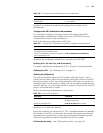
138 CHAPTER 5: IP ROUTING PROTOCOL OPERATION
By default, route dampening is disabled.
The parameters in the command are dependent on one another. If one parameter
is configured, other parameters must be specified.
Configuring BGP Preferences
Three types of routes may be involved in BGP:
■ Routes learned from external peers
■ Routes learned from internal peers
■ Routes with local origins
You can set preference values for the three types of routes.
Perform the following configurations in BGP view..
The ebgp-value, ibgp-value and local-value parameters are in the range of 1 to
256. By default, the first two is 256 and the last one is 130.
Configuring the BGP Timer
When receiving an open message to set up a BGP connection, a BGP speaker
needs to calculate a hold timer. The smaller the gap between its own hold time
and the one received in the message will be selected as the negotiated hold timer.
Then, BGP will send a keepalive message and set a keepalive timer. If the
negotiation result is 0, no keepalive message is transmitted and the
holdtime-interval value is ignored.
Perform the following configurations in BGP view..
By default, the interval for sending keepalive packet is 60 seconds. The interval for
sending holdtime packet is 180 seconds.
Clear route attenuation information and
eliminating the suppression of the route
reset dampening [ network-address [ mask ]
]
Cancel BGP route dampening undo dampening
Table 117 Configuring BGP Preferences
Operation Command
Configure BGP preference preference ebgp-value ibgp-value local-value
Restore the default preference undo preference
Table 118 Configuring the BGP Timer
Operation Command
Configure BGP Timer peer { group-name | peer-address } timer
keep-alive keepalive-interval hold
holdtime-interval
Restore the default value of the timer peer { group-name | peer-address } timer
Table 116 Configuring BGP Route Dampening
Operation Command


















